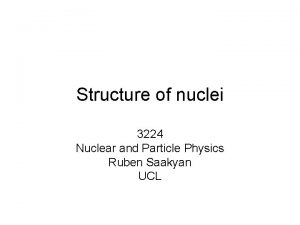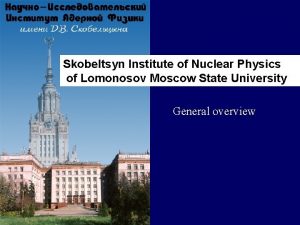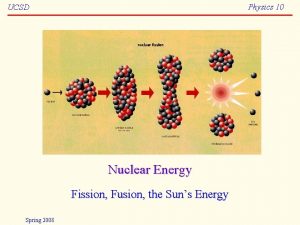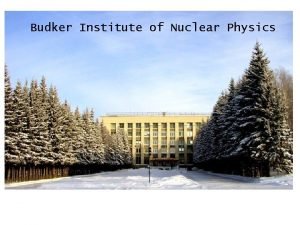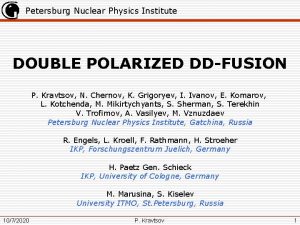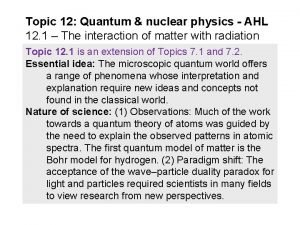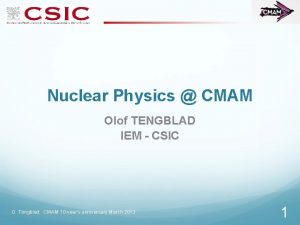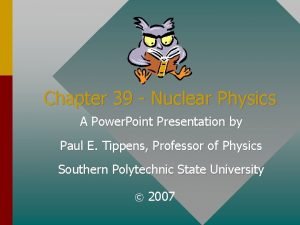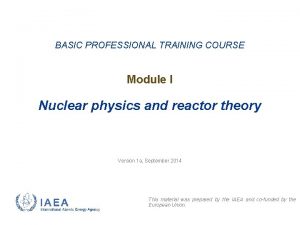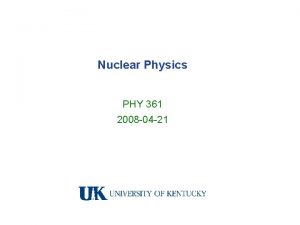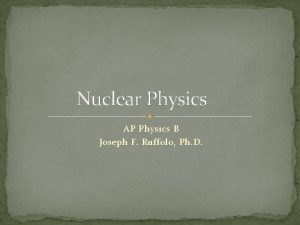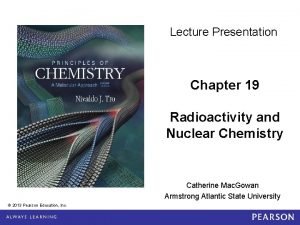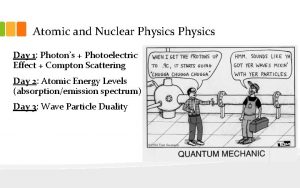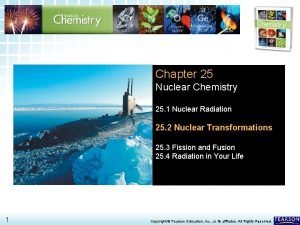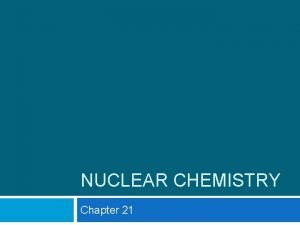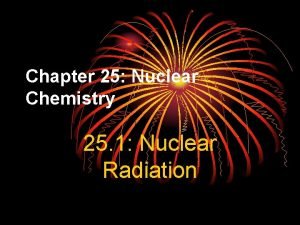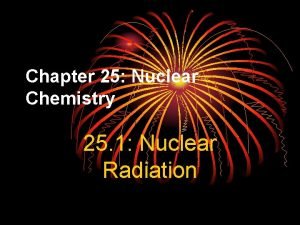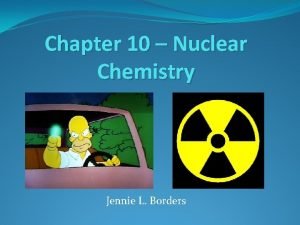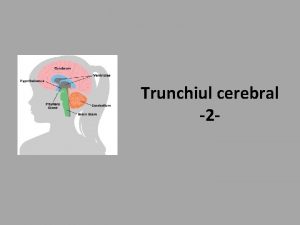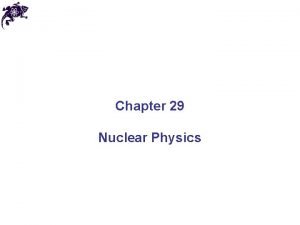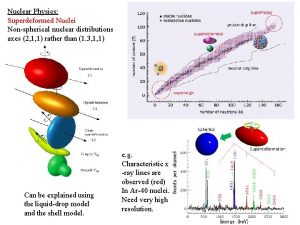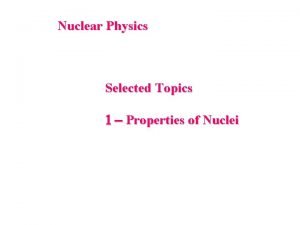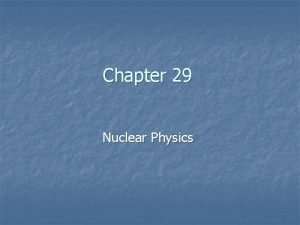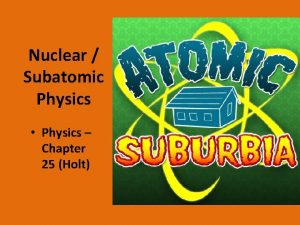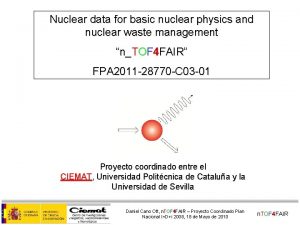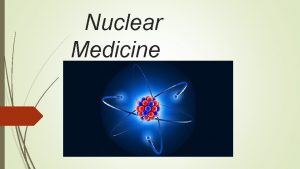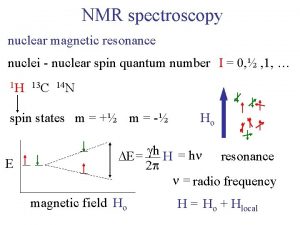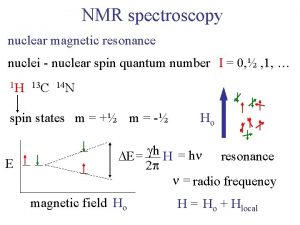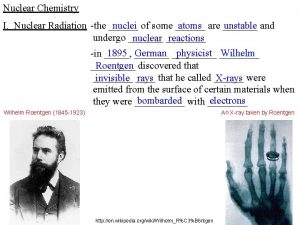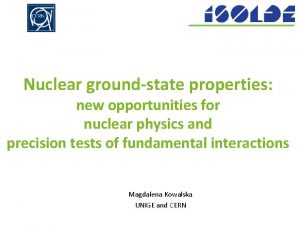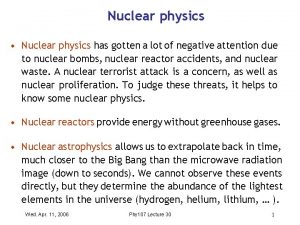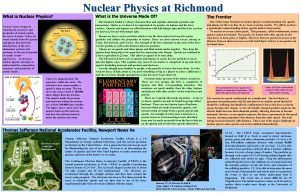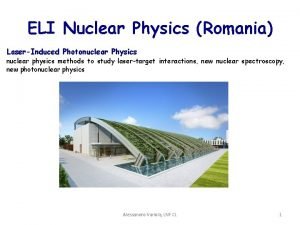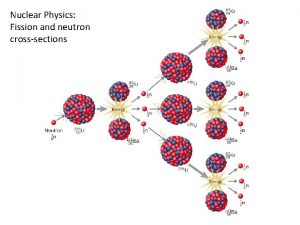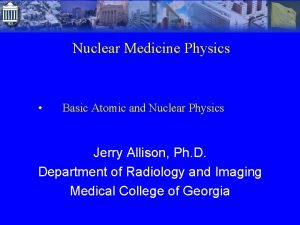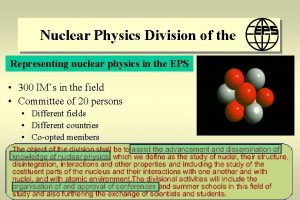Chapter 29 Nuclear Physics Properties of Nuclei All







































- Slides: 39

Chapter 29 Nuclear Physics

Properties of Nuclei • All nuclei are composed of protons and neutrons (exception: ordinary hydrogen) • The atomic number, Z, equals the number of protons in the nucleus • The neutron number, N, is the number of neutrons in the nucleus • The mass number (not the same as the mass), A, is the number of nucleons in the nucleus: A = Z + N • Nucleon is a generic term used to refer to either a proton or a neutron

Properties of Nuclei • Symbol: • X is the chemical symbol of the element • Example: • Mass number is 27; atomic number is 13; contains 13 protons and 14 = 27 – 13 neutrons • The Z may be omitted since the element can be used to determine Z • The nuclei of all atoms of a particular element must contain the same number of protons

Properties of Nuclei • The nuclei may contain varying numbers of neutrons • Isotopes of an element have the same Z but differing N and A values. For example: • The proton has a single positive charge, +e (e = 1. 602 177 33 x 10 -19 C) • The electron has a single negative charge, -e • The neutron has no charge, which makes it difficult to detect

Mass • It is convenient to express masses using unified mass units, u, based on definition that the mass of one atom of C-12 is exactly 12 u: 1 u = 1. 660 559 x 10 -27 kg • Mass can also be expressed in Me. V/c 2 (from E = m c 2) 1 u = 931. 494 Me. V/c 2 Masses Particle Proton kg u Me. V/c 2 1. 6726 x 10 -27 1. 007276 938. 28 Neutron 1. 6750 x 10 -27 1. 008665 939. 57 Electron 9. 109 x 10 -31 5. 486 x 10 -4 0. 511

The Size of the Nucleus • From scattering experiments, Rutherford found an expression for how close an alpha particle moving toward the nucleus can come before being turned around by the Coulomb force • The KE of the particle must be completely converted to PE • d gives an upper limit for the size of the nucleus (e. g. , for gold, d = 3. 2 x 10 -14 m and for silver, d = 2 x 10 -14 m)

The Size of the Nucleus • Such small lengths are often expressed in femtometers where 1 fm = 10 -15 m Also called a fermi • Since the time of Rutherford, many other experiments have concluded that most nuclei are approximately spherical with the average radius of • ro = 1. 2 x 10 -15 m Enrico Fermi 1901 – 1954

Density of Nuclei • The volume of the nucleus (assumed to be spherical) is directly proportional to the total number of nucleons • This suggests that all nuclei have nearly the same density • Nucleons combine to form a nucleus as though they were tightly packed spheres

Nuclear Stability • There are very large repulsive electrostatic forces between protons • These forces should cause the nucleus to fly apart • The nuclei are stable because of the presence of another, short-range force, called the nuclear force • This is an attractive force that acts between all nuclear particles • The nuclear attractive force is stronger than the Coulomb repulsive force at the short ranges within the nucleus

Nuclear Stability • Light nuclei are most stable if N=Z • Heavy nuclei are most stable when N > Z • As the number of protons increase, the Coulomb force increases and so more nucleons are needed to keep the nucleus stable • No nuclei are stable when Z > 83

Chapter 29 Problem 7 (a) Find the speed an alpha particle requires to come within 3. 2 × 10− 14 m of a gold nucleus. (b) Find the energy of the alpha particle in Me. V.

Binding Energy • The total energy of the bound system (the nucleus) is less than the combined energy of the separated nucleons • This difference in energy is called the binding energy of the nucleus • It can be thought of as the amount of energy you need to add to the nucleus to break it apart into separated protons and neutrons

Binding Energy

Binding Energy • Except for light nuclei, the binding energy is about 8 Me. V per nucleon • The curve peaks in the vicinity of A = 60 • Nuclei with mass numbers greater than or less than 60 are not as strongly bound as those near the middle of the periodic table • The curve is slowly varying at A > 40, suggesting that the nuclear force saturates • A particular nucleon can interact with only a limited number of other nucleons

Radioactivity • Radioactivity is the spontaneous emission of radiation • Radioactivity is the result of the decay (disintegration) of unstable nuclei • Three types of radiation can be emitted • 1) Alpha particles: 4 He nuclei) • 2) Beta particles: either electrons or positrons (a positron is the antiparticle of the electron, similar to the electron except its charge is +e) • 3) Gamma rays: high energy photons

Distinguishing Types of Radiation • A radioactive beam is directed into a region with a magnetic field • The gamma particles carry no charge and they are not deflected • The alpha particles are deflected upward • The beta particles (electrons) are deflected downward, whereas the positrons would be deflected upward

Penetrating Ability of Particles • Alpha particles: barely penetrate a piece of paper • Beta particles: can penetrate a few mm of aluminum • Gamma rays: can penetrate several cm of lead

The Decay Constant • The number of particles that decay in a given time is proportional to the total number of particles in a radioactive sample ΔN = - λ N Δt • λ: the decay constant; determines the rate at which the material will decay • The decay rate or activity, R, of a sample is defined as the number of decays per second

Decay Curve • The decay curve follows the equation N = No e- λt • Another useful parameter is the half-life defined as the time it takes for half of any given number of radioactive nuclei to decay

Decay Curve

Units • The unit of activity, R, is the Curie, Ci: 1 Ci = 3. 7 x 1010 decays/second • The most commonly used units of activity are the m. Ci and the µCi • The SI unit of activity is the Becquerel, Bq: 1 Bq = 1 decay/second (therefore, 1 Ci = 3. 7 x 1010 Bq) Maria Skłodowska-Curie 1867 – 1934 Antoine Henri Becquerel 1852 – 1908

Chapter 29 Problem 24 A building has become accidentally contaminated with radioactivity. The longest-lived material in the building is strontium-90. (The atomic mass of is 89. 907 7. ) If the building initially contained 5. 0 kg of this substance, and the safe level is less than 10. 0 counts/min, how long will the building be unsafe?

Decay – General Rules • When one element changes into another element, the process is called spontaneous decay or transmutation • The sum of the mass numbers, A, must be the same on both sides of the equation • The sum of the atomic numbers, Z, must be the same on both sides of the equation • Conservation of mass-energy and conservation of momentum must hold

Alpha Decay • When a nucleus emits an alpha particle it loses two protons and two neutrons (N decreases by 2; Z decreases by 2; A decreases by 4) • Symbolically • X: parent nucleus; Y: daughter nucleus • Example: decay of 226 Ra (half life is 1600 years) • Excess mass is converted into kinetic energy • Momentum of the two particles is equal and opposite

Beta Decay • During beta decay, the daughter nucleus has the same number of nucleons as the parent, but the atomic number is changed by one • Symbolically: • The emission of the electron is from the nucleus, which contains protons and neutrons • The process occurs when a neutron is transformed into a proton and an electron • The energy must be conserved: the energy released in the decay process should almost all go to kinetic energy of the electron (KEmax)

Beta Decay • Experiments showed that few electrons had this amount of kinetic energy • To account for this “missing” energy, Pauli proposed the existence of another particle, which Fermi later named the neutrino • Properties of the neutrino: • Zero electrical charge • Mass much smaller than the electron, probably not zero • Spin of ½ • Very weak interaction with matter

Beta Decay • Symbolically • is the symbol for the neutrino; antineutrino is the symbol for the • Therefore, in beta decay, the following pairs of particles are emitted: either an electron and an antineutrino or a positron and a neutrino

Gamma Decay • Gamma rays are given off when an excited nucleus “falls” to a lower energy state (similar to the process of electron “jumps” to lower energy states and giving off photons) • The gamma ray photons are very high in energy relative to light • The excited nuclear states result from “jumps” made by a proton or neutron • The excited nuclear states may be the result of violent collision or more likely of an alpha or beta emission

Gamma Decay • Example of a decay sequence • The first decay is a beta emission • The second step is a gamma emission • The C* indicates the Carbon nucleus is in an excited state • Gamma emission doesn’t change either A or Z

Natural Radioactivity • There are unstable nuclei found in nature, which give rise to natural radioactivity • Nuclei produced in the laboratory through nuclear reactions exhibit artificial radioactivity • Three series of natural radioactivity exist (see table 29. 2): 1) Uranium 2) Actinium 3) Thorium (processes through a series of alpha and beta decays and ends with a stable isotope of lead, 208 Pb)

Nuclear Reactions • Structure of nuclei can be changed by bombarding them with energetic particles • These changes are called nuclear reactions • As with nuclear decays, the atomic numbers and mass numbers must balance on both sides of the equation • E. g. , alpha particle colliding with nitrogen: • Balancing the equation allows for the identification of X, so the reaction is

Chapter 29 Problem 39 Identify the unknown particles X and X’ in the following nuclear reactions:

Answers to Even Numbered Problems Chapter 28: Problem 4 1. ρn/ρa = 8. 6 × 1013

Answers to Even Numbered Problems Chapter 28: Problem 8 a) 1. 9 × 10 -15 m b) 7. 4 × 10 -15 m

Answers to Even Numbered Problems Chapter 28: Problem 10 (a) 1. 11 Me. V/nucleon (b) 7. 07 Me. V/nucleon (c)(c) 8. 79 Me. V/nucleon (d)(d) 7. 57 Me. V/nucleon

Answers to Even Numbered Problems Chapter 28: Problem 18 (a)8. 06 d (b)(b) It is probably 13153 I

Answers to Even Numbered Problems Chapter 28: Problem 20 1. 2. 29 g

Answers to Even Numbered Problems Chapter 28: Problem 38 1. 4 4 He He, 2 2

Answers to Even Numbered Problems Chapter 28: Problem 42 a) 10 5 B b) – 2. 79 Me. V
 Lesson 15 nuclear quest nuclear reactions
Lesson 15 nuclear quest nuclear reactions Fisión nuclear vs fision nuclear
Fisión nuclear vs fision nuclear Quantum and nuclear physics
Quantum and nuclear physics Magic number in nuclear physics
Magic number in nuclear physics Skobeltsyn institute of nuclear physics
Skobeltsyn institute of nuclear physics Nuclear energy in physics
Nuclear energy in physics Scattering cross section in nuclear physics
Scattering cross section in nuclear physics Budker
Budker Petersburg nuclear physics institute
Petersburg nuclear physics institute Physics topic 12
Physics topic 12 Nuclear physics
Nuclear physics Nuclear physics topics for presentation
Nuclear physics topics for presentation Nuclear physics
Nuclear physics Nuclear physics
Nuclear physics Nuclear physics
Nuclear physics Nuclear physics b
Nuclear physics b Magic number
Magic number Nuclear physics
Nuclear physics Budker
Budker Nuclear physics day
Nuclear physics day Name
Name Why does it happen
Why does it happen University physics with modern physics fifteenth edition
University physics with modern physics fifteenth edition Physics research questions ib
Physics research questions ib Lateral strain
Lateral strain Extensive and intensive examples
Extensive and intensive examples Chemical and physical properties
Chemical and physical properties 12x12x12x12x12x12x12
12x12x12x12x12x12x12 Chapter 25 nuclear chemistry answer key
Chapter 25 nuclear chemistry answer key Chapter 21 review nuclear chemistry
Chapter 21 review nuclear chemistry Chapter 25 nuclear chemistry
Chapter 25 nuclear chemistry Chapter 25 nuclear chemistry
Chapter 25 nuclear chemistry Chapter 10 nuclear chemistry
Chapter 10 nuclear chemistry Chapter 10 nuclear chemistry
Chapter 10 nuclear chemistry Multiple nuclei model example
Multiple nuclei model example Squatter settlements ap human geography
Squatter settlements ap human geography Sprawl geography definition
Sprawl geography definition Bid rent theory
Bid rent theory Lama cvadrigemina
Lama cvadrigemina The multiple nuclei model
The multiple nuclei model



